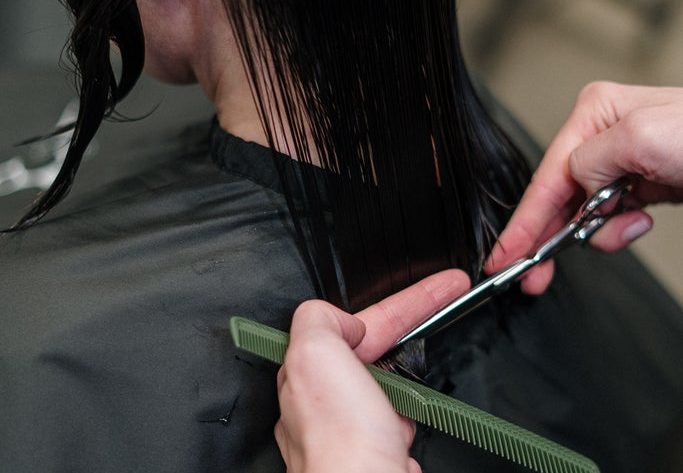Breakups, dating drama, fertility struggles, and family feuds — hairdressers are privy to all manner of personal stories. As we relax, unwind, and feel someone else’s fingers through our hair, we tend to let down our guard, and often, the conversation can spill over into a free therapy session. The salon chair has long served as a sanctuary where we instinctively find solace in sharing our deepest thoughts and emotions. But unbeknown to us, hairdressers repeat the same interaction up to eight or nine times a day. It’s little wonder, then, that this is taking a serious toll on their mental health.
In July of this year, L’Oréal Professionnel unveiled Head Up, an initiative focusing on salon workers’ mental health, after discovering that hairstylists spend an average of 2,000 hours per year listening to their clients. It is reported that out of the 1,750 hair professionals surveyed, 65% have experienced anxiety, burnout, or depression during their professional career. Currently no formal training exists within the wider industry to help stylists navigate difficult conversations and to set boundaries with clients.
Kelly Vowles, salon owner of Pixal-Rose Hair Design insists that dealing with clients’ emotional baggage should not just be considered “part of the job.” “At the start of this year, I had to deal with two bereavements,” Vowles tells R29. “I truly believe my recovery has been hindered because my job involves listening to and responding to other people’s trauma, or constantly being asked about my own trauma all day long.” Vowles continues, “I’m a really strong person; I love chatting. It was only when I went through several traumatic experiences myself that I realized this aspect of the job wasn’t healthy.” We often joke about hairdressers moonlighting as therapists, says Vowles, but she stresses that most lack the training to handle the range of topics that they encounter.
What is trauma dumping?
This is where the risk of so-called “trauma-dumping” comes in. “Trauma dumping is offloading a traumatic experience onto someone who potentially isn’t qualified (to deal with it),” explains clinical psychologist Karen Gerber. As a result, a person can experience “secondary trauma,” which leaves them struggling to make sense of or process the information they’ve just received, says Gerber. She points out that there is a crucial difference between venting to your hairdresser and seeing a licensed, professional therapist. “The content of the conversation might feel very similar, but the reality is that the therapist would have had four to ten years of training.”
“The main concern is that nobody asks permission before they tell you things. No one asks, ‘Have you got capacity for me to tell you my sadness today?’”
Hayley Jepson, hairdresser
Hayley Jepson has been a hairdresser for 30 years and is a qualified psychotherapist. Her Instagram account, @the.resilient.hairdresser, focuses on mental health in the hair industry and has amassed a large following of stylists and colorists. “When you’re a therapist, people are going to come in every hour and offload. You make an agreement that that’s going to happen,” Jepson points out. “When you decide to be a hairdresser, you don’t agree to that. Clients can tell you absolutely traumatizing things or really happy stuff. It’s a wide spectrum.” The main concern is that nobody asks permission before they tell you things, says Jepson. “No one asks, ‘Have you got capacity for me to tell you my sadness today?’”
Jepson explains that as appointments have become longer (think: painstaking balayage and intricate layering) trauma dumping is becoming more of a problem than ever before as we’re now more comfortable in the presence of our chosen hairdresser. “Colorists like myself have gone from spending an hour and a half per client, to four hours,” says Jepson. If a client is offloading the entire time, without a single thought to their hairdresser, it’s no wonder the mental health of salon workers is suffering.
What are the risks of trauma dumping on your hairdresser?
But it’s a tricky situation to navigate. As salon-owner Edward James points out, sometimes you need to understand what a client is going through when it comes to doing their hair properly. “We’d typically get a client coming in saying ‘I want to chop all my hair off and dye it a different color!’ and I’d say, ‘What’s going on in your life?’ Then you find out she went through a really traumatic breakup and might not want such a drastic change in the long-term. So it’s important to understand the full picture.” Similarly, as colorist Rachel Selt notes, occasionally talking about what’s bothering us can, in some cases, be therapeutic for the hairdresser too. “I’ve been through post-natal depression,” Selt shares with R29, “so being able to open up to my clients and have them open up with me about their experiences has really helped me.”
If a client is offloading the entire time, without a single thought to their hairdresser, it’s no wonder the mental health of salon workers is suffering.
The deep bond between hairdressers and their clients has paved the way for expanded responsibilities, with some now taking on additional roles to help clients who could be in danger. Last year in the US, a new law in Tennessee required all hairdressers to undergo training to recognize domestic violence. In the UK, barber Tom Chapman founded the charity The Lion’s Barber Collective, an international team of barbers who are trained in how to spot the signs of ill mental health in the hope that this may prevent men from taking their own lives.
While it’s certainly commendable that hairdressers are receiving training that could potentially save lives, we should also consider the well-being and perspectives of the hairdressers themselves. “Clients offload on hairdressers everyday — this isn’t something we signed up for, but it happens,” Jepson notes. “We have no training or systems in place to support and help us manage this extra stress. We should be talking more about the effect this is having on hairdressers. They are burnt out, exhausted, and can dread going to work.”
What is compassion fatigue?
What many hairdressers don’t realize is that they are suffering from “compassion fatigue,” says Jepson. This term is used to describe the adverse psychological effects (such as stress and mental exhaustion) which may arise from empathizing with and listening to clients on a daily basis — and this can weigh heavy on anyone. A 2020 study found that compassion fatigue interferes with our ability to think clearly and balance our emotions. The study also revealed that individuals with compassion fatigue may pull away from others, become socially isolated and feel physically exhausted.
“I did the consultation, got her shampooed, rushed to the staff room, and burst out crying.”
Andrea Dorata, L’Oréal Professionnel artist and SAlon Owner
Jepson has taken to Instagram to lift the lid on compassion fatigue, a commonly discussed topic in the world of therapy but rarely — if ever — examined in regard to hairdressing. “I think compassion fatigue contributes massively to hairdressers burning out,” says Jepson in a recent Instagram reel, which amassed many comments in agreement from long-suffering hairdressers. Jepson reports feeling exhausted by the conversation-side of the job. In October, she is launching a course for hairdressers to discuss all things burnout and boundaries. “I want to encourage hairdressers to look after themselves properly so they can manage this side of the job,” Jepson says.
Junior staff are particularly at risk of compassion fatigue and burnout. “I remember the first time one of my clients told me she had cancer; I must have been 21,” recalls Andrea Dorata, L’Oréal Professionnel artist and owner of Dorata Hairdressing. “She was 33, with two kids and was pregnant. I did the consultation, got her shampooed, rushed to the staff room, and burst out crying.” Even more experienced stylists can be affected. Adam Bennett, senior stylist at Stonehills Hairdressing, thought he had become used to clients offloading their trauma, but a recently upsetting encounter with a new client left a lasting impact on him: “I recently did the hair of someone who told me she’d been suffering domestic abuse. It really choked me up. There were tears in my eyes. It took me a week to stop thinking about it. I kept finding it creeping into my head. Luckily, in my salon, we have access to a free mental health helpline, but not everyone has that.”
For Stewart Roberts, founder of the charity Haircuts 4 Homeless, protecting his team’s mental health is paramount, especially when working with homeless clients who have suffered severe trauma and abuse. “Communication is key,” he tells R29. “Stylists can share stories and how they feel, and we have access to resources and a list of organizations, like Samaritans, that stylists can refer clients on to.”
How do you know if you should see a therapist?
Before setting up the charity, Roberts owned a salon for 30 years and is no stranger to clients oversharing and offloading. “The magic of what hairdressers do is touch — it breaks that invisible barrier. That’s why the hairdresser-client relationship is so special,” he explains. “Just be aware. If you feel that your stylist may be getting uncomfortable with how much you’re sharing with them, ask, ‘Do you mind me talking about this?’ It doesn’t take a lot to see that someone’s feeling awkward and wants to change the subject.”
All of this is not to say you can’t enjoy a close relationship with your hairdresser. But it’s worth reflecting on why you need to offload as much as you do, says Gerber. If you’re worried you might be treating your hairdresser like a therapist, consider exploring whether you need actual therapy. Online resources from Betterhelp, Talkspace, and Online-Therapy.com are all good places to start.
Either way, when you sit back in the salon chair, it’s always important to think twice before launching into your latest diatribe. “It’s a cliche,” concludes Vowles, “but some of us actually do enjoy talking about holidays!”
This story was originally reported on Refinery29UK.
Like what you see? How about some more R29 goodness, right here?
So, How Is Nutrient-Infused Braiding Hair, Really?
I Tried Gisou's Honey Infused Hair Repair Serum
I Tried "Pearl Balayage" Hair Color & Love It



